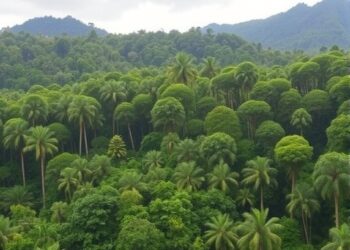Climate and other environmental changes sometimes drive people to migrate, especially if the land no longer supports a population’s way of life. In turn, mobile populations alter the environment in which they settle.
Climate and other environmental changes sometimes drive people to migrate, especially if the land no longer supports a population’s way of life. In turn, mobile populations alter the environment in which they settle.
Migration dynamics and their interactions with climate and environment in rural areas are poorly understood, according to a new perspective paper led by Colorado State University. The paper, published in Nature Sustainability, proposes that greater focus on these processes is needed to develop sustainability policies for dealing with inevitable climate and land change and related migration.
Displacement of large numbers of people caused by disaster or conflict captures the public’s attention, and studies of migration typically focus on international or urban migration. However, most migration occurs within national borders in response to slow changes unrelated to disaster or conflict.
Lead author Jonathan Salerno, an ecologist who studies human behavior and adaptation, said that rural-to-rural migration will become increasingly relevant in the coming years under climate and land change. People will choose smaller, less costly moves over big, expensive moves if they can help it, but shorter moves can compound local and regional environmental changes.
“Initially, people are going to move and adapt within their current livelihoods in ways that they know how to do,” said Salerno, an associate professor in the Warner College of Natural Resources. “We need to understand these rural-to-rural migration systems if we’re going to better address large-scale urban and international moves in a sustainable way.”
The authors suggest that land system science – which studies the land itself as well as how people use it – should be integrated into migration studies because they are interconnected, and understanding these relationships will lead to better policies.
Climate change is expected to disproportionately impact low- and middle-income countries, and anticipating and managing future land use will be key to adaptation, the paper states. Policy options could include giving rural people better tools to adapt in place to climate and environmental changes, so migration becomes less necessary, or better land-use planning in receiving areas.
“Recent estimates of international migrants globally are around 280 million, and internal migrants are perhaps two to three times that,” Salerno said, adding that few rural-to-rural migration data exist because regional moves aren’t commonly tracked by government entities. “We focus on these dynamics of internal migration, paying specific attention to rural areas in low- and middle-income countries where people are particularly reliant on and impacted by changing climates and environments.”
Factors that influence migration
Salerno said that migration decisions are based on a combination of large-scale, structural factors – like politics, economy or environmental change – and personal resources such as social networks, money, land and livestock.
“Everybody is a potential migrant, it’s just a matter of if and how a decision threshold is crossed,” he added, noting that his team’s research focuses on adaptive migration and not involuntary migration.
Rural migration is frequently tied to a slow decline in land productivity. Extended drought or a decrease in soil quality can motivate people to move. Salerno and his collaborators are looking at these understudied, slow-onset changes, particularly rainfall.
“Small changes in a marginal dryland area can make agriculture no longer tenable,” he said. “One bad rainfall year, one bad harvest or a pest outbreak could be the trigger that bumps you over the threshold.”
Salerno’s team developed a model to simulate migration decisions based on the interplay between broad structural forces and individual agency. The agent-based Migration-Land Systems Model helps to illustrate the integration of migration and land system fields.
Co-author and model developer Rekha Warrier, a postdoctoral fellow in the Department of Human Dimensions of Natural Resources, said that the model conveys the complexity of migration and shows how different factors can be explored systematically.
The team conducted simulations with unique combinations of factors that influence migration, including rainfall, social conflict, land ownership, local social networks and non-local social networks. They revealed that social networks are key in migration decisions, but networks act differently when households experience acute drought versus slow rainfall decline. Strong local networks and less significant rainfall decline were less likely to yield the decision to move.
The model also identified the importance of links between areas, or telecouplings. Livelihood activities and changing rainfall patterns in one area can predict land change in the corresponding area receiving an influx of people.
“The model allows exploration of landscape teleconnections where environmental or social events at a location cascade via migration to impact land function and ecosystem services in other distant landscapes,” Warrier said.
Salerno has been collecting data on rural migration among agropastoralist communities in Tanzania since 2009. The team plans to apply the model to the data to analyze migration scenarios in Tanzania in response to climate change.
Randall Boone, a research scientist with CSU’s Natural Resource Ecology Laboratory, and Atmospheric Science Assistant Professor Patrick Keys co-authored the perspective paper, along with collaborators Andrea Gaughan (University of Louisville), Forrest Stevens (University of Louisville), Lazaro Johana Mangewa (Sokoine University of Agriculture), Felister Michael Mombo (Sokoine University of Agriculture), Alex de Sherbinin (Columbia University), Joel Hartter (CU Boulder) and Lori Hunter (CU Boulder).
Journal
Nature Sustainability
Article Title
Rural migration under climate and land systems change
Article Publication Date
16-Aug-2024




